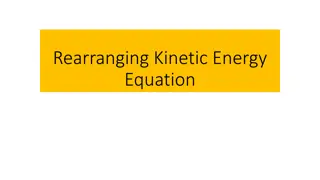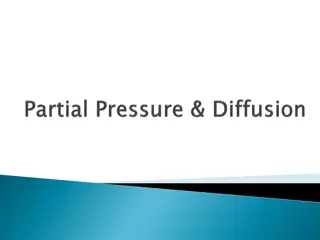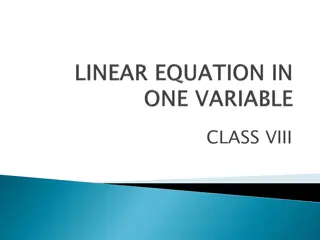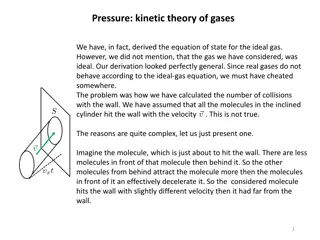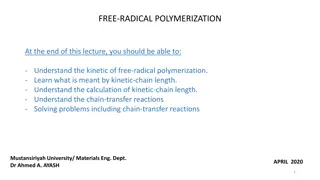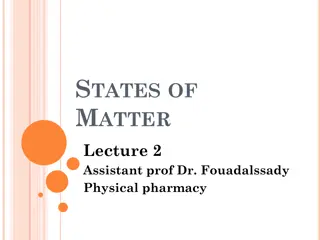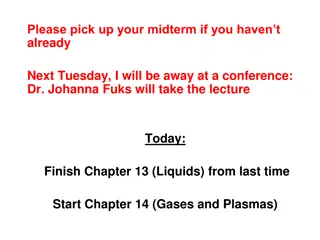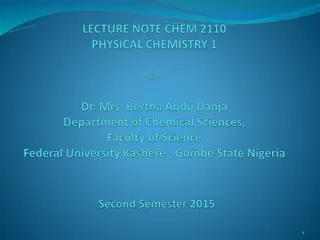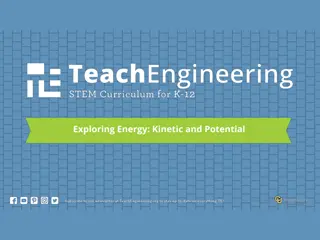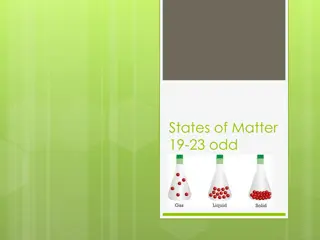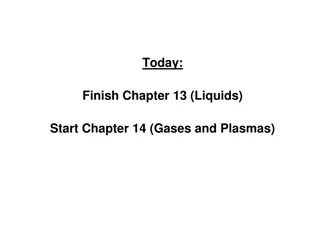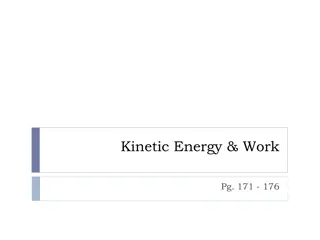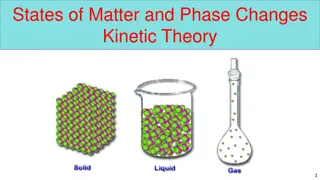Understanding Kinetic Theory of Gases: Key Concepts and Equations
Exploring the kinetic theory of gases, this content covers essential concepts such as ideal gas behavior, molar mass, the equation of state, and isobaric/isothermal processes. Discover the relationship between pressure, volume, and temperature in gases, along with practical examples and calculations.
Download Presentation

Please find below an Image/Link to download the presentation.
The content on the website is provided AS IS for your information and personal use only. It may not be sold, licensed, or shared on other websites without obtaining consent from the author. Download presentation by click this link. If you encounter any issues during the download, it is possible that the publisher has removed the file from their server.
E N D
Presentation Transcript
Chapter 19 Kinetic Theory of Gases
Few Facts about ideal Gases All molecules of the ideal gas are identical. They don t interact with each other. All real gases at low density behaves as an ideal gas. They hit the wall of the container to generate pressure. When a gas is heated (temperature increases) at fixed volume, molecules moves faster, ie pressure increases
Fact of 1 mole =Molar mass (M) Molar mass (M) = gram representation of its molecular weight For example: 1 mole of H2 = 2 g 1 mole of He = 4 g 1 mole of O2 = 32 g 1 mole of H2O = 18 g 1 mole of any gas contains 6.02x1023 molecules. Avogadro's number (NA ) = 6.02x1023 1 mole of H2 = 2 g = 6.02x1023 H2 molecules 1 mole of He = 4 g = 6.02x1023 He atoms 1 mole of O2 = 32 g = 6.02x1023 O2 molecules 1 mole of N2 = 28 g = 6.02x1023 N2 molecules 1 mole of H2O = 18 g = 6.02x1023 H2O molecules If a gas has n mole, m gram mass and N molecules m N = = n M N A
Equation of STate 1 mole of any gas at fixed volume(V) and temperature(T) exerts same pressure (P) in the container. The relation is: PV = RT R = 8.31J/mol.K, is a molar gas constant For n mole of gas PV = nRT If there are N molecules in the container n = N N A NkT PV = Where, k = R/NA = 1.38x10-23 J/K = Boltzmann constant Pressure (P), Volume (V) and temperature (T) are called thermodynamic variables
Equation of State T52-Q#15. Two moles of ideal gas are at 20 oC and a pressure of 200 kPa. If the gas is heated to 40 oC, and its pressure is reduced by 30%, what is the new volume? (Ans: 37 L) Equation of state for n mole of any gas: nRT PV = For the initial state = ( ) i PV nRT 0 0 0 For the final state = ( ) ii PV nRT Dividing (ii) by (i) PV PV T = 0 T 0 0
Keeping Pressure (P) Constant: Isobaric Change Temperature and Volume at fixed Pressure Work done in isobaric process ???? =??? ???? ?? ?? =?? = ( ) W P V V ? ? 0 V T V T = 0 0 T052: Q#2. One mole of an ideal gas is cooled at constant pressure process from 100 oC to 40 oC. Calculate the work done during the process. (Ans: 500 J)
Keeping Temperature (T) Constant: Isothermal Change Pressure and Volume at fixed Temperature Work done in isothermal process V = W PdV ???? ?? ?? =? ? ???? =? ? V 0 ? ?0 nRT P = V V 1 V = W nRT dV = PV PV V o 0 0 V V = ln W nRT 0 Three isotherms If V > V0 , expansion W >0 If V < V0 , compression W <0
Example: T72-Q16. An ideal gas is initially at a pressure of 1.40 atm and has a volume of 3.50 L. It expands isothermally to a final pressure of 0.600 atm. What is the work done in the process? (Ans: + 420 J) Pi = 0.019 x105 Pa, Vi = 3.5x10-3 m3 Pf = 0.019 x105 Pa, Vf = ?, W =?
T81-Q16. A 0.825 mol of an ideal gas undergoes an isothermal process. The initial volume is 0.20 m3 and the final volume is 0.30 m3. If the heat added to the gas is 1000 J, find the temperature of the gas. (Ans: 360 K) T61-Q15. 6 moles of an ideal gas are kept at a constant temperature of 60 .0 oC while the pressure of the gas is increased from 1.00 atm to 4.00 atm. Find the heat involved during this process. (Ans: -23 kJ) Example: T51-Q#14. An ideal gas expands at constant pressure of 120 kPa from (a) to (b) as shown in the Figure 1. It is then compressed isothermally to point (c) where the volume is is 40 L. Find the net work done during these two processes ( Ans: 1060 J ) T41-5: A cylinder with a frictionless piston contains 0.2 kg of water at 100 degrees Celsius. What is the change in internal energy of water when it is converted to steam at 100 degrees Celsius at constant pressure of 1 atm. [Density of steam = 0.6 kg/m**3, water = 10**3 kg/m**3] (A1: 418 kJ. )
Keeping Volume (V) Constant: Isochoric Change Pressure and Temperature at fixed volume ???? ?? ?? =?? ???? =??? ? ? T0 = 273.15K ?? ?? =? Triple point of water ? Work done in isovolumetric process = = 0 W P V Example: T002: Q#11) In a constant-volume gas thermometer, the pressure is 0.019 atm at 100 degrees Celsius. Find the temperature when the pressure is 0.027 atm. (Ans: 2570C). Pi = 0.019 atm, Ti = 100C Pf = 0.027 atm, Tf = ? Constant gas thermometer
Example: T002: Q#11) In a constant-volume gas thermometer, the pressure is 0.019 atm at 100 degrees Celsius. Find the temperature when the pressure is 0.027 atm. (Ans: 2570C). Pi = 0.019 atm, Ti = 100C Pf = 0.027 atm, Tf = ?
19.4: Pressure Temperature and RMS speed For one molecule: Monatomic molecule = = ' ( ' ) 2 ' p m v m v m v 1 1 1 1 x x x x 2 1 2 ' ' m v m v p = = = 1 x x F 1 x 2 / t l v l 1 x -v 2 1 2 1 ' ' m v 3 m v F v = = = x x P 1 2 l l V For N molecules l = + P P P P 1 2 N + + 2 1 2 2 2 Nx '( ) m v v v = x x P V ) + + 2 1 2 2 2 Nx ( ) ' N v v v m V '( ? =???2 Nm V = x x P = 2 x P v N av ? 2 2 2 =??? =???? But = = 2 2 2 ( ) ( ) ( ) v v v ?? = + + 2 2 2 2 ( ) ( ) ( ) ( ) v v v v x av y av z av 3 3 av x av y av z av 2 2 rms nMv ? =? ? =???? = P 3 V ? 3? 3 RT = 2 rms P V nMv 1 PV = = nRT vrms 3 M
Important part: Conclusion 2 nMv 3 = rms P V 3-dimension 3 RT = vrms M T81-Q15. The mass of an oxygen molecule is 16 times that of a hydrogen molecule. At room temperature, the ratio of the rms speed of an oxygen molecule to that of a hydrogen molecule is: (Ans: )
19.5: Translational KE Gas atoms translate in 3-dimension with velocity Translational KE of N molecules 3 RT = 3 vrms = KET nRT M 2 1 KE = 2 rms mv 3 N T 2 = KE RT T 2 N A 3 m =2 KET RT 3 M = T031:Q1: Two moles of nitrogen are in a 3-liter container at a pressure of 5.0x106 Pa. Find the average translational kinetic energy of a molecule. A1: 1.9x10-20 J. KET NkT 2 m N = = n k = R/NA = 1.38x1023 J/K Boltzmann constant M N A 3 = KET nRT 2 Translational KE of n-mole of monatomic molecule Translational KE doesn t depend on mass, interesting!
Internal Energy (Ei) Internal Energy of gas is the total energy due to translation, rotation and vibration of gas molecules Vibrational Energy is too small, so we may ignore it Ei = KET + KER f 2 f 2 = Ei nRT = Ei nR T f = degree of freedom For mono-atomic gas , f = 3 (3 translation, no rotation) For diatomic gas f= 5 (3 translation, 2 rotation) For polyatomic gas f =6 (3 translation, 3 rotation)
Degree of freedom (f) Monatomic Molecule: One atom (eg: He, Ne, Ar etc) It can just translate (move, x, y, z) in three directions but cannot rotate (f) = 3 3 3 = 0 KE = = KET nRT Ei nRT R 2 2 Diatomic molecule: two atoms (eg: H2, O2, N2 etc) It can just translate (move, x, y, z) in three directions and can rotate in two directions (f) = 5 3 2 5 = = = KET nRT KER nRT Ei nRT 2 2 2 Polyatomic molecule: more than two atoms Eg: NH3, H2O, CH4 etc It can translate (move, x, y, z) in three directions and can rotate in three directions (f) = 6 3 3 6 = = = KET nRT KER nRT Ei nRT 2 2 2
T51-Q#18 Two moles of a monatomic ideal gas with an RMS speed of 254 m/s are contained in a tank that has a volume of 0.15 m3. If the molar mass of the gas is 0.39 kg/mole, what is the pressure of the gas? A 1.1x105 Pa. T81-Q14. What is the change in the internal energy of a 1.00 mole of a monatomic ideal gas that goes from point 1 (T1= 455K and pressure P1 = 1.00 atm) to point 2 (T2 = 300 K and pressure P2 = 1.00 atm.)? (Ans: -1930 J)
Molar heat at constant volume (cv) Specific Heat: Amount of heat required to raise the temperature of 1mole of gas by 10C or 1K at constant volume Q If you keep volume constant and add heat then gas is behaving like liquid or solid which has fixed volume. = = v Cv Q nC T n T From first low of thermodynamics: = Q W E Therefore, the amount of heat is used to increase temperature only. Constant Volume: W = 0 = E Q f 2 = v nR T nC T fR Cv= 2 Constant Volume: 3 R 2 = = 12 5 . / . Cv J mole K For monatomic
Molar heat at constant pressure (cp) Specific Heat: Amount of heat required to raise the temperature of 1mole of gas by 10C or 1K at constant pressure Q = p = Q nC T Cp n T From first low of thermodynamics: Q E W = + If you keep pressure constant and add heat, you need to change volume. Some of the heat is used to increase temperature and some of the heat is used to do work to change volume. = = nC T nC T P V v p nC T nC T nR T v p = + C C R p v + 2 2 f 2 f = + = Cp R R R Constant Pressure
Molar Gas Constant + C 2 + f R 2 f p = = = 2 f 2 C R f v For Monatomic Gas: (f =3) 3 + = 2 5 = 3 3 For Diatomic Gas: (f =5) + 5 2 7 = = 5 5 For polyatomic Gas: (f =6) + 6 2 4 = = 6 3
The form of a sound wave traveling through air is s(x,t)=smcos(kx+ t), where x in meters and t in seconds. What is the shortest time interval that any air molecule takes along the path to move between displacements s= + 0.2sm and s = - 0.2sm? A pipe open at both ends has a fundamental frequency of 667Hz. What is the third harmonic frequency of this tube if one end is closed?
A sinusoidal wave is described as : y(x, t) = (0.100) sin (4.32 (x/5.00 - t-3.00/2.00), What its frequency? A gas has its temperature changed from 7500 K to 300 K. The RMS speed:
Adiabatic Expansion The expansion in which heat is not involved: Sudden expansion and compression The equation of adiabatic equation is PV = . const = = . (1) PV const . (2) PV const 0 0 = PV PV 0 0 = = 1 1 1 1 TV TV T P T P 0 0 0 0 T71-Q19. An ideal monatomic gas, undergoes an adiabatic expansion to one-third of its initial pressure. Find the ratio of the final volume to the initial volume. (Ans: 1.9)
Free Expansion The expansion in which change in internal energy is zero. 3 2 T = nR T = 0 E = 0 = 0 T T = PV PV 0 0 T61-Q15. 6 moles of an ideal gas are kept at a constant temperature of 60 .0 oC while the pressure of the gas is increased from 1.00 atm to 4.00 atm. Find the heat involved during this process. (Ans: -23 kJ)
Summary Slide Important Formulae W Q E = Major Formulae: V P = = Conversion formulae R k = = , P V NkT M N = = N NA A nRT m n = m N P V nRT = = n M N R A k = V f E Q W = ln W nRT N A V i fR 3 RT Cv= 2 rms nMv f 2 3 = vrms = , P 2 = Ei nR T M V = + 3 C C R = p v KEav 3 kT 2 RT C = vrms 3 p = = = Ei nRT Ei nR T M C 2 2 PV = v . const = i= E nC T E nC 3 T i v v f = degree of freedom For mono-atomic gas f = 3 For diatomic gas f= 5 For polyatomic gas f =6 R 2 = = 12 5 . / . Cv J mole K V V = ln W nRT C p = PV = . const C 0 v = , PV PV = 1 1 TV TV 0 0 0 0
Ch 19-Basic T11-Q13. Which one of the following properties of a gas is NOT consistent with the kinetic theory of gasses? A) The average speed of the gas molecules is smaller at highertemperatures. B) Gas molecules are widely separated. C) Gases fill whatever space is available to them. D) Gas molecules move rapidly in a random fashion. E) Gas molecules make elastic collisions with the walls of the container. T103-Q14. A 5 moles of an ideal gas expand isobarically from Ti = 25 C to Tf = 75 C. Calculate the work done by the gas during this process. A) 2.1 x 103 J T111-Q15. An ideal gas is taken from state A to state B through the process shown on the P-V diagram in Figure 3. How much heat is added to the gas in this process? A) 2.4 104J T92-Q19. Heat flows into a monatomic gas, and the volume increases while the pressure is kept constant. What fraction of the heat energy is used to do the expansion work of the gas? A) 2/5
RMS Speed T91-Q15. An ideal gas undergoes a constant-pressure process. The RMS speed : A) Increases as the volume increases. B) Decreases as the volume increases. C) Decreases as the temperature increases. D) Doubles if the temperature is doubled. E) Decreases by one-half if the temperature is doubled. T111-Q14. A container having 150 kg of an ideal gas has a volume of 8.00 m3. If the gas exerts a pressure of 5.00 105 Pa, what is the rms speed of the molecules? A) 283 m/s T103-Q15. An ideal gas has a density of 3.75 kg/m3 and is at a pressure of 1.00 atm. Determine the rms speed of the molecules of this gas. A) 284 m/s T102- Q14. Two mole of hydrogen gas at 27.00 oC are compressed through isobaric process to half of the initial volume. If we assume hydrogen to be an ideal gas, the final RMS speed of the hydrogen molecules is: (Molar mass of Hydrogen = 2.020 grams) A) 1361 m/s T82-Q15. A 0.050-m3 container has 5.00 moles of argon gas at a pressure of 1.00 atm. What is the rms speed of the argon molecules? (MAr = 40.0 g/mole) A) 275 m/s
Adiabatic T92-Q18. In an adiabatic process for an ideal gas, the pressure decreases. Which of the following statements is CORRECT? A) The internal energy decreases. B) The internal energy increases. C) The internal energy remains constant. D) The work done is zero. E) The work is done on the system. T91-Q17. An ideal monatomic gas, initially at 300 K, occupies a volume of 1.50 m3. It expands adiabatically to twice its original volume. What is the final temperature of the gas? A) 190 K T103-Q17. One mole of an ideal monatomic gas is initially at a pressure of 1.01 105 Pa, a temperature of 300 K, and has a volume of 1.00 L. It is compressed adiabatically to a volume of 0.0667 L. Calculate the magnitude of the work done during this process. A) 19.0 kJ T101-Q15. A 7.8 moles of an ideal gas is at an initial temperature of 24 0C and has an initial volume of 0.04 m3. The gas expands adiabatically to a volume of 0.08 m3. Calculate the work done by the gas during this expansion. ( = 1.67) A) 11 kJ
T52-Q#7. Consider one mole of a monatomic gas taken through the cycle shown in the figure 2. Find the change in internal energy of the system for the adiabatic process a b. (Ans: 100 kJ) T81-Q13: Fig. 3. shows a cycle undergone by 1.0 mol of a monatomic ideal gas. What is the heat added to the gas during the whole cycle? (Ans: 520 J) T111-Q16. Four moles of a monatomic ideal gas, initially at 300 K, expand adiabatically to double the initial volume. Calculate the change in the internal energy of the gas. A) 5.53 kJ T102-Q13. A monatomic ideal gas at a pressure 1.01 x 105 Pa expands adiabatically to 3 times its initial volume. The new pressure is: A) 1.62 x 104 Pa
Internal Energy T103-Q16. The internal Energy of a certain volume of gas enclosed in a container DOES NOT depend on: A) The molecular mass of the gas B) The momentum of the gas molecules C) The temperature of the gas D) The kinetic energy of the molecules of the gas E) The number of atoms in a molecule of the gas T101-Q16. A 9.0 g of helium gas undergoes a cyclic process as shown Figure 3. Find the workdone in the process from point B C. (molar mass of helium is 4.0 g/mole) A) 19 kJ T101-Q14. When work is done on an ideal gas of N diatomic molecules in thermal insulation the temperature increases by (where W is the magnitude of the work) A) 2W/5Nk T92-Q17. Five moles of an ideal monatomic gas with an initial temperature of 127 oC expand, and in the process absorb 1200 J as heat and do 2100 J of work. What is the final temperature of the gas? A) 113 C
Isothermal and mixed T103-Q16. An ideal monatomic gas is taken through cycle A->B->C -> A, shown in the p-V diagram of Figure 3, where process B- >C is isothermal. Calculate the net work done in one cycle. A) 4088 J, on the gas T102-Q15. In the isothermal process shown in Figure 2 the work done on 5.000 mole of monatomic ideal gas is 2275 J. Find the ratio of final to initial volumes. A) 0.8332
T-111-Ch19 Q13. Which one of the following properties of a gas is NOT consistent with the kinetic theory of gasses? A) The average speed of the gas molecules is smaller at highertemperatures. B) Gas molecules are widely separated. C) Gases fill whatever space is available to them. D) Gas molecules move rapidly in a random fashion. E) Gas molecules make elastic collisions with the walls of the container. Q14. A container having 150 kg of an ideal gas has a volume of 8.00 m3. If the gas exerts a pressure of 5.00 105 Pa, what is the rms speed of the molecules? A) 283 m/s Q15. An ideal gas is taken from state A to state B through the process shown on the P-V diagram in Figure 3. How much heat is added to the gas in this process? A) 2.4 104J Q16. Four moles of a monatomic ideal gas, initially at 300 K, expand adiabatically to double the initial volume. Calculate the change in the internal energy of the gas. A) 5.53 kJ
T-103-Ch19 Q14. A 5 moles of an ideal gas expand isobarically from Ti = 25 C to Tf = 75 C. Calculate the work done by the gas during this process. A) 2.1 x 103 J Q15. An ideal gas has a density of 3.75 kg/m3 and is at a pressure of 1.00 atm. Determine the rms speed of the molecules of this gas. A) 284 m/s Q16. An ideal monatomic gas is taken through cycle A->B->C -> A, shown in the p-V diagram of Figure 3, where process B- >C is isothermal. Calculate the net work done in one cycle. A) 4088 J, on the gas Q17. One mole of an ideal monatomic gas is initially at a pressure of 1.01 105 Pa, a temperature of 300 K, and has a volume of 1.00 L. It is compressed adiabatically to a volume of 0.0667 L. Calculate the magnitude of the work done during this process. A) 19.0 kJ
T-102-Ch19 Q13. A monatomic ideal gas at a pressure 1.01 x 105 Pa expands adiabatically to 3 times its initial volume. The new pressure is: A) 1.62 x 104 Pa Q14. Two mole of hydrogen gas at 27.00 oC are compressed through isobaric process to half of the initial volume. If we assume hydrogen to be an ideal gas, the final RMS speed of the hydrogen molecules is: (Molar mass of Hydrogen = 2.020 grams) A) 1361 m/s Q15. In the isothermal process shown in Figure 2 the work done on 5.000 mole of monatomic ideal gas is 2275 J. Find the ratio of final to initial volumes. A) 0.8332 Q16. The internal Energy of a certain volume of gas enclosed in a container DOES NOT depend on: A) The shape of the container B) The molecular mass of the gas C) The temperature of the gas D) The kinetic energy of the molecules of the gas E) The number of atoms in a molecule of the gas Solution: A) and B)
T-101-Ch19 Q13. A sample of argon gas (molar mass 40 g) is at four times the absolute temperature of a sample of hydrogen gas (molar mass 2.0 g). The ratio of the rms speed of the argon molecules to that of the hydrogen molecules is A) 1/ 5 Q14. When work is done on an ideal gas of N diatomic molecules in thermal insulation the temperature increases by (where W is the magnitude of the work) A) 2W/5Nk Q15. A 7.8 moles of an ideal gas is at an initial temperature of 24 0C and has an initial volume of 0.04 m3. The gas expands adiabatically to a volume of 0.08 m3. Calculate the work done by the gas during this expansion. ( = 1.67) A) 11 kJ Q16. A 9.0 g of helium gas undergoes a cyclic process as shown Figure 3. Find the workdone in the process from point B C. (molar mass of helium is 4.0 g/mole) A) 19 kJ
T-92-Ch19 Q17. Five moles of an ideal monatomic gas with an initial temperature of 127 oC expand, and in the process absorb 1200 J as heat and do 2100 J of work. What is the final temperature of the gas? A) 113 C Q18. In an adiabatic process for an ideal gas, the pressure decreases. Which of the following statements is CORRECT? A) The internal energy decreases. B) The internal energy increases. C) The internal energy remains constant. D) The work done is zero. E) The work is done on the system. Q19. Heat flows into a monatomic gas, and the volume increases while the pressure is kept constant. What fraction of the heat energy is used to do the expansion work of the gas? A) 2/5 Q20. Two moles of an ideal monatomic gas go through the cycle shown in the p-V diagram in Figure 2. For the complete cycle, 800 J of heat flows out of the gas. States A and B have temperatures TA = 200 K and TB = 300 K. What is the work during process C A? A) 2462 J
T-91-Ch19 Q15. An ideal gas undergoes a constant-pressure process. The RMS speed : A) Increases as the volume increases. B) Decreases as the volume increases. C) Decreases as the temperature increases. D) Doubles if the temperature is doubled. E) Decreases by one-half if the temperature is doubled. Q16. An ideal gas occupies a volume of 1.5 m3 at 20 C and under a pressure of 0.10 atm. The gas is heated at constant pressure to 50 C. What is the work done by the gas? A) 1.6 kJ Q17. An ideal monatomic gas, initially at 300 K, occupies a volume of 1.50 m3. It expands adiabatically to twice its original volume. What is the final temperature of the gas? A) 190 K
T-82-Ch19 Q14. Three moles of a monatomic ideal gas at room temperature T1 = 300K and pressure P1 undergo an isobaric then an adiabatic expansion, as shown in Figure 3. Calculate the final temperature of the gas T3. ( = 1.67). A) 457 K Q15. A 0.050-m3 container has 5.00 moles of argon gas at a pressure of 1.00 atm. What is the rms speed of the argon molecules? (MAr = 40.0 g/mole) A) 275 m/s Q16. In the PV diagram shown in Figure 4, the ideal gas does 10 J of work when taken along the isothermal process from a to b and 8.0 J of work when taken along the adiabatic process from b to c. What is the change in internal energy of the gas when it is taken along the straight path from a to c? A) 8.0 J
T-81-Ch19 Q12.A gas expands from a volume of 2.00 m3 to a volume of 6.00 m3 along two different paths as shown in Fig 2. The heat added to the gas along path IAF equals 1.68 106 J. Find the heat added during path IF. (Ans: 1.48 106 J) Q13: Fig. 3. shows a cycle undergone by 1.0 mol of a monatomic ideal gas. What is the heat added to the gas during the whole cycle? (Ans: 520 J) Q14. What is the change in the internal energy of a 1.00 mole of a monatomic ideal gas that goes from point 1 (T1= 455K and pressure P1 = 1.00 atm) to point 2 (T2 = 300 K and pressure P2 = 1.00 atm.)? (Ans: -1930 J) Q15. The mass of an oxygen molecule is 16 times that of a hydrogen molecule. At room temperature, the ratio of the rms speed of an oxygen molecule to that of a hydrogen molecule is: (Ans: ) Q16. A 0.825 mol of an ideal gas undergoes an isothermal process. The initial volume is 0.20 m3 and the final volume is 0.30 m3. If the heat added to the gas is 1000 J, find the temperature of the gas. (Ans: 360 K)
T-72-Ch19 Q15. An ideal monatomic gas expands from state A to state B along the straight line path shown. Below in Fig. 1. Calculate the heat absorbed by the gas in the process. (Ans: +962 J) Q16. An ideal gas is initially at a pressure of 1.40 atm and has a volume of 3.50 L. It expands isothermally to a final pressure of 0.600 atm. What is the work done in the process? (Ans: + 420 J) Q17. One mole of an ideal monatomic gas is taken through an adiabatic process, as shown in the Fig. 2. Calculate the work done in this process. (Ans: 7.8 kJ)
T-71-Ch19 Q13. A gas initially at a temperature of 0 oC and a pressure of 100 kPa is compressed isothermally from 30 L to 20 L. What is the work required? (1.2 kJ) Q19. An ideal monatomic gas, undergoes an adiabatic expansion to one-third of its initial pressure. Find the ratio of the final volume to the initial volume. (Ans: 1.9) Q20. process shown in the figure1. The net heat absorbed during the complete cycle is 1000 J. Find the work done by the gas for the process c to a. (Ans: -1000 J) A gas undergoes the cyclic
T-62-Ch19 Q14. One mole of an ideal monatomic gas, initially at 300 K, expands adiabatically to twice of its initial volume. The work done in this process is: (Ans: 1.4 J) Q15. One mole of a monatomic ideal gas absorbs heat at constant pressure and its temperature rises from 40 C to 90 C. The heat absorbed in the process is (Ans: 1.0 kJ) Q16. Two moles of an ideal monatomic gas are compressed adiabatically from A to B and then further compressed isothermally from B to C as shown in the figure 1. Calculate the net heat transfer in the process from A to C. (Ans: -6.7 kJ)
T-61-Ch19 Q14. One mole of a diatomic ideal gas is initially at a temperature of 127 oC and has a volume of 0.090 m3. The gas is compressed adiabatically to a volume of 0.045 m3. What is the final temperature? (Ans: 528 K) Q15. 6 moles of an ideal gas are kept at a constant temperature of 60 .0 oC while the pressure of the gas is increased from 1.00 atm to 4.00 atm. Find the heat involved during this process. (Ans: -23 kJ) Q16. A sample of one mole of an ideal gas is taken through the cyclic process ABCA as shown in the Figure 1. What is the net energy added to the gas as heat during the cycle? (Ans: 12 kJ)
T-52-Ch19 Q#2. One mole of an ideal gas is cooled at constant pressure process from 100 oC to 40 oC. Calculate the work done during the process. (Ans: 500 J) Q#10. A sample of argon gas ( MAr = 40 g/mole) is at four times the absolute temperature of hydrogen gas (MH = 2 g/mole). The ratio of the rms speed of the argon atoms to that of hydrogen molecules is: (Ans: 0.45 ) Q#20. A monatomic ideal gas is compressed adiabatically from an initial pressure of 1 atm and volume of 800 cm3 to a volume of 400 cm3. If the initial temperature of the gas is 20 oC, what is the final temperature of the gas? (Take =1.67) (Ans: 466 K.)
T-51-Ch19 Q#13. A sample of an ideal gas is compressed by a piston from 10 m3 to 5 m3 and simultaneously cooled from 540 K to 270 K. As a result there is: (Ans: No change in pressure. Q#14. An ideal gas expands at constant pressure of 120 kPa from (a) to (b) as shown in the Figure 1. It is then compressed isothermally to point (c) where the volume is is 40 L. Find the net work done during these two processes ( Ans: 1060 J ) Q#15. Two moles of ideal gas are at 20 oC and a pressure of 200 kPa. If the gas is heated to 40 oC, and its pressure is reduced by 30%, what is the new volume? (Ans: 37 L) Q#16. In the Figure 2 below, paths 1 and 3 are isotherms and paths 2 and 4 are adiabatic. Which path results in the highest heat transferred to the gas? (Ans: Path 1)




